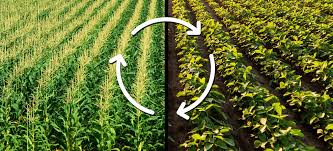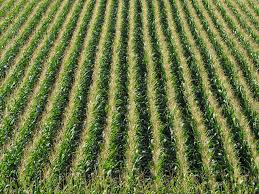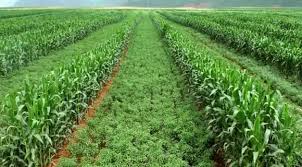A cropping system is not only focused on the types of crops grown but also on how those crops are distributed in the field at any given time and how this distribution changes over time. In addition, the level of management and amount of resource inputs are integral aspects of a cropping system.
This article explains the various cropping systems and the conditions that give rise to such systems. The advantages and disadvantages of each cropping system are also discussed.
Definition of Cropping System
The term cropping system is used to describe the pattern in which crops are grown in a given area over a period of time, including the technical and managerial resources utilized.
The cropping system of a given area is concerned with how crops are distributed in the field at any time and how this distribution changes over time. Additionally, the level of management and resource inputs are important aspects of a cropping system.
Read Also: Switchgrass (Panicum Virgatum): Uses, Benefits and Facts
Classification of Cropping Systems

Cropping systems are classified based on the following criteria:
1. Distribution of crops in time: Shifting cultivation, continuous cropping, monoculture, or crop rotation may be practiced.
2. Distribution of crops in space: Intercropping or sole cropping can be adopted.
3. Level of management and resources used: It can be either intensive or extensive production.
4. Type of crop grown: Orchard, arable cropping, pasturing, or forestry may be practiced.
Shifting Cultivation
In shifting cultivation, the farm is not at a permanent location. Instead, a piece of land is cleared, farmed for a few years, and then abandoned in favor of a new site. While the new site is being farmed, natural vegetation grows on the old site.
After several years of bush fallows, the farmer returns to the original location. In tropical Africa, the practice of moving the home with the farm has been discontinued, with homes remaining stationary.
1. Common features:
i. A site under bush fallow for several years is selected.
ii. The vegetation is cleared by burning.
iii. Crops are grown for one to three years, starting with those that require high nutrients and ending with those that require fewer nutrients.
iv. Low levels of technology, input, and management are used.
v. Simple hand tools are used, and labor requirements are high, but yields are low.
2. Factors necessitating shifting cultivation:
i. Declining soil fertility and increasing population.
ii. High incidence of diseases and pests.
iii. Social or religious customs that may dictate the abandonment of a site before fertility levels become marginal.
3. Disadvantages
i. Discourages high input levels: Since farms stay in one location only briefly, there is no incentive to invest in permanent structures like sheds, irrigation, or pest control.
ii. Requires large land areas: A great deal of land is necessary to maintain the system.
iii. Inefficient land and labor use: Low efficiency in both areas is common.
Continuous Cropping
Continuous cropping involves cultivating the same piece of land year after year, unlike shifting cultivation. Fallowing may occur, but never for more than one or two seasons. Without prolonged fallow periods, other soil management practices must be implemented to maintain high fertility.
1. Soil fertility management:
i. Application of fertilizers and other amendments to boost fertility.
ii. Careful crop selection and crop combinations, such as crop rotation and intercrops.
iii. Introducing short-term fallow periods with leguminous cover crops to increase organic matter.
2. Advantages:
i. Efficient land utilization: A high percentage of land is under crops at any given time.
ii. Permanent structures: It is economically feasible to erect permanent structures on the farm.
Read Also: Sudangrass (Sorghum × drummondii) Complete Guide
Crop Rotation

Crop rotation is the practice of growing different crops in sequence on the same piece of land. A good crop rotation promotes soil productivity and includes legumes for nitrogen fixation, grasses or legume sod crops for humus, and cultivated crops for weed control.
1. Factors affecting crop rotation:
i. Adaptation of crops to soil, climate, and economic conditions.
ii. The prevalence of weeds, pests, and diseases in the area.
iii. The need to spread labor throughout the year.
2. Principles of crop rotation:
i. The main crop should be planted after legumes or a fallow period to take advantage of high soil fertility.
ii. Deep feeders should alternate with shallow feeders to maintain nutrient levels in different soil layers.
iii. Crops susceptible to the same pests or diseases should not follow each other in the rotation.
3. Types of crop rotation: Farmers may treat the entire field as one plot, rotating crops sequentially, or divide the field into plots, growing different crops in each plot and rotating them over time.
4. Advantages of Crop Rotation
i. Controls diseases and pests: Pathogens and pests are more likely to die off when their host crop is replaced by a different one.
ii. Weed control: Some crops can smother weeds, and the absence of certain host crops reduces weed populations.
iii. Spreads labor demands: Dividing the field into plots balances labor requirements and reduces the risk of crop failure.
iv. Reduces soil erosion: Grass-legume mixtures in rotation help minimize soil erosion compared to continuous cropping.
Monoculture

Monoculture is the practice of continuously cultivating the same crop on the same piece of land, such as sugarcane farming in Kwara State, Nigeria.
1. Disadvantages:
i. Increases disease and pest risks: The same host crop is always present, leading to a buildup of pests and diseases.
ii. Depletes soil nutrients: It encourages the rapid depletion of soil nutrients and deterioration of soil structure.
iii. Higher risk of crop failure: Monoculture is more vulnerable to crop failure due to pests, diseases, or environmental stress.
2. Advantages: Monoculture allows for maximum focus on a single crop, concentrating production efforts.
Intercropping
Intercropping is the practice of growing two or more crops simultaneously on the same field. This can be done in various forms:
i. Row intercropping: Growing different crops in separate rows.
ii. Mixed cropping: Growing crops intermingled randomly.
iii. Relay intercropping: Sowing a second crop between stands of an existing crop before the first crop is harvested, allowing them to grow together for part of their growing period.
1. Factors that Determine Crop Combination and Spatial Arrangement
i. Tillage practices: Tillage determines how crops are positioned based on their specific needs. For example, crops like yam, which require deep tilled soil, are planted at the top of mounds, while moisture-loving crops like rice are planted in lower areas. Intermediate crops, such as maize or pumpkins, are planted between the yam and rice, ensuring optimal use of the soil layers.
ii. Target and subsidiary crops: Farmers often prioritize certain crops over others, classifying them as the main (target) or secondary (subsidiary) crop. This influences the proportion and spatial arrangement of the crops. A dominant crop will occupy a larger area, while smaller crops will fill in available spaces.
iii. Nature of crops: Different crops occupy different amounts of space. For instance, pumpkins and melons spread over a large area and produce high economic yields. Conversely, crops like rice require denser planting to achieve a meaningful yield.
2. Evaluating Yield from Intercropping
In intercropping, the relative yield of each crop is compared to its expected yield if grown alone. This relative yield is calculated by dividing the yield of the crop in the intercropping system by the yield of that crop when grown as a sole crop.
For example:
If a maize-cowpea combination yields 1.5 tonnes/hectare of maize and 0.25 tonnes/hectare of cowpeas, while sole crop yields are 2.0 tonnes/hectare for maize and 0.5 tonnes/hectare for cowpeas, the relative yield is:
Maize: 1.5/2.0 = 0.75
Cowpeas: 0.25/0.5 = 0.50
The total relative yield, known as the Land Equivalent Ratio (LER), is the sum of the relative yields of all crops in the intercrop. In this case, LER = 0.75 + 0.50 = 1.25. An LER greater than 1.0 indicates that intercropping yields more than sole cropping, while an LER less than 1.0 suggests the opposite.
3. Advantages of Intercropping
i. Efficient resource utilization: Intercropping allows crops to complement each other in resource use. For example, maize or melons can be intercropped with yams, taking advantage of the time when yams are still establishing.
ii. Efficient space utilization: Deep-rooted crops can be grown with shallow-rooted ones, utilizing different soil layers.
iii. Better resource exploitation: Certain crops, like legumes, fix nitrogen, benefiting companion crops like cereals.
iv. Beneficial interactions: Plantains can provide shade for young cocoa seedlings, or nitrogen-fixing legumes can enrich the soil for cereals.
v. Risk buffering: Growing multiple crops simultaneously reduces the risk of total crop failure, as one crop can compensate for another’s failure.
vi. Labor distribution: Intercropping spreads labor more evenly across the year, avoiding peak labor periods.
vii. Yield stability: When one component crop fails, other crops in the intercrop can absorb its share of resources, leading to better overall yields.
viii. Pest and disease control: Intercropping slows the spread of pests and diseases, as crops may act as physical barriers or be immune to certain threats.
4. Disadvantages of Intercropping
i. Tailored management challenges: Production practices cannot be optimized for a specific crop, making it difficult to cater to individual crop needs.
ii. Pest and disease control difficulties: Pesticides suitable for one crop may harm others in the intercrop, complicating pest and disease management.
iii. Mechanization limitations: Intercropping makes mechanized operations like planting, weeding, and harvesting more challenging due to the diversity of crops.
Cropping Systems in Africa

- Shifting cultivation and intercropping are predominant among smallholder farmers in Tropical Africa, while large-scale farmers in East and Southern Africa, along with irrigated agriculture in Egypt, practice sole cropping with crop rotation.
- Plantation agriculture focuses on sole cropping for crops like oil palm, cocoa, rubber, coffee, and tea. However, intercropping with food crops is sometimes practiced when plantations are young.
- Arable cash crops like tobacco and groundnuts are grown as sole crops, either under shifting cultivation or continuous cropping with rotation.
Cropping systems revolve around the efficient distribution of crops in both time and space, influenced by available resources, climate, and farmer expertise. Different cropping systems, such as shifting cultivation, intercropping, and sole cropping, come with their respective advantages and challenges.
Understanding the principles behind crop rotation and spatial arrangement helps farmers achieve better yields while managing resources sustainably.
Do you have any questions, suggestions, or contributions? If so, please feel free to use the comment box below to share your thoughts. We also encourage you to kindly share this information with others who might benefit from it. Since we can’t reach everyone at once, we truly appreciate your help in spreading the word. Thank you so much for your support and for sharing!

